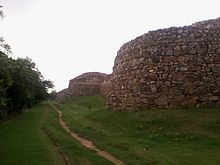Tomara dynasty | |||||||||
|---|---|---|---|---|---|---|---|---|---|
| c. 736 CE–c. 1152 CE | |||||||||
Location of the Tomaras and neighbouring South Asian polities in 1000 CE.[1] | |||||||||
| Status |
| ||||||||
| Capital | |||||||||
| Common languages | |||||||||
| Religion | Hinduism | ||||||||
| Government | Monarchy | ||||||||
| History | |||||||||
• Established | c. 736 CE | ||||||||
• Disestablished | c. 1152 CE | ||||||||
| |||||||||
| Today part of | India | ||||||||

The Tomaras of Delhi (also called Tomar dynasty in modern vernaculars due to schwa deletion) ruled parts of present-day Delhi and Haryana in India during 8th-12th century. Their rule over this region is attested to by multiple inscriptions and coins. In addition, much of the information about them comes from medieval bardic legends. They belonged to the Tomar clan of the Rajputs.[2][3]
They were displaced by the Chahamanas of Shakambhari in the 12th century, who took over their capital in Delhi, but who were themselves soon displaced by the Ghurid ruler Muhammad of Ghor in 1192 CE.[4]
- ^ Schwartzberg, Joseph E. (1978). A Historical atlas of South Asia. Chicago: University of Chicago Press. pp. 31, 32. ISBN 0226742210.
- ^ Upinder Singh (2004). The Discovery of Ancient India: Early Archaeologists and the Beginnings of Archaeology. Permanent Black. p. 73. ISBN 978-81-7824-088-6.
Discussion of the histories of various Rajput clans, such as the Chauhans, Kachhvahas, Chandelas, Pratiharas and Tomaras on the basis of a wide range of sources-literary, epigraphic, numismatic, bardic accounts and local traditions
- ^ Kulke, Hermann; Rothermund, Dietmar (2004). A History of India. Psychology Press. p. 117. ISBN 978-0-415-32919-4.
When Gurjara Pratiharas power declined after the sacking of Kannauj by the Rashtrakutas in the early tenth century many Rajput princes declared their independence and founded their own kingdoms, some of which grew to importance in the subsequent two centuries. The better known among those dynasties were the Chaulukyas or Solankis of Gujarat and Kathiawar, the Chahamanas (i.e. Chauhans) of eastern Rajasthan (Ajmer and Jodhpur) and the Tomaras who had founded Delhi (Dhillika) in 736 but had been displaced by the Chauhans in the twelfth century.
- ^ Ray, Himanshu Prabha (5 September 2018). Decolonising Heritage in South Asia: The Global, the National and the Transnational. Taylor & Francis. p. 142. ISBN 978-0-429-80285-0.
